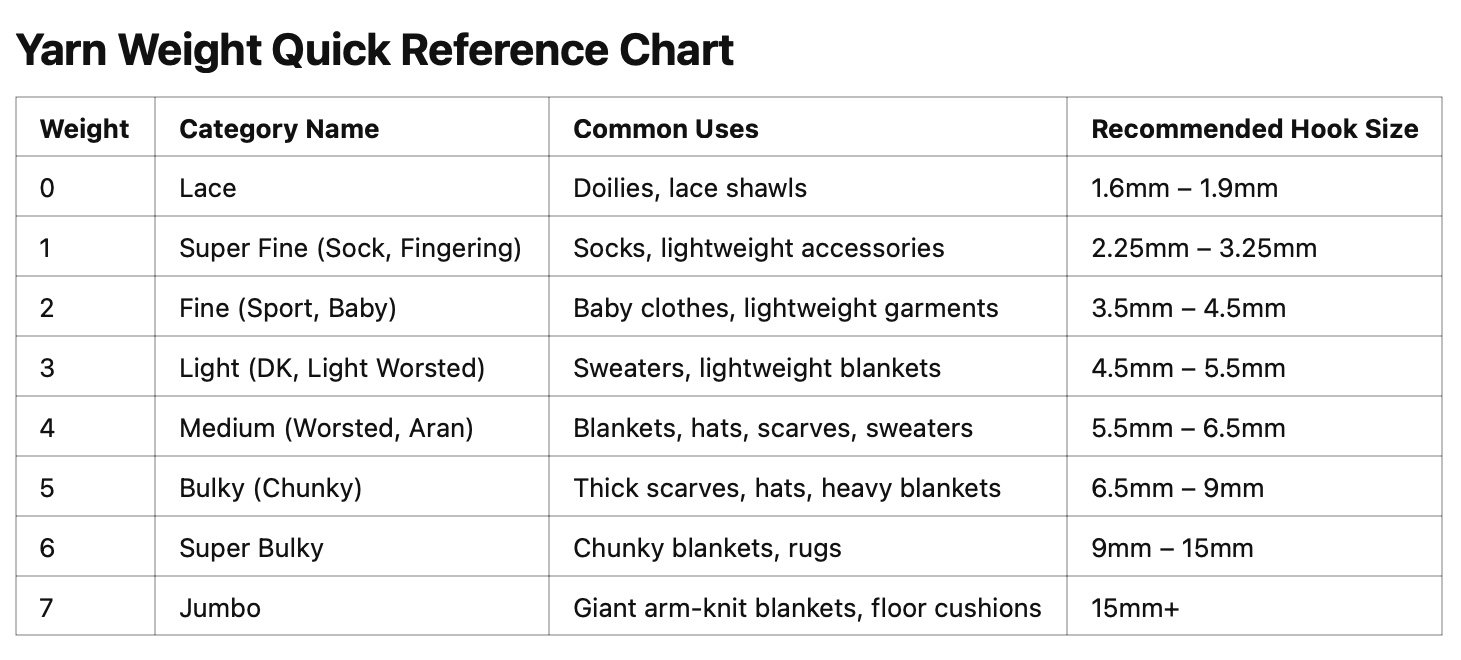Understanding Yarn Weights and What They Mean
If you’re new to crochet or knitting, you’ve probably seen yarn labels mentioning words like “worsted,” “bulky,” or “sport weight” — and wondered what they mean. Don’t worry! Understanding yarn weights is easier than it sounds, and it’s key to choosing the right yarn for your projects. In this guide, we’ll break it all down so you can feel confident the next time you pick up a skein.
What Is Yarn Weight?
Yarn weight doesn’t refer to how heavy the ball of yarn is — it refers to the thickness of the yarn strand itself.
Different projects require different yarn thicknesses. Some yarns are fine and delicate, while others are thick and chunky.
Knowing the yarn weight helps you:
• Choose the right hook or needle size.
• Get the right look and feel for your project.
• Follow patterns correctly.
Standard Yarn Weight Categories
Here’s a simple breakdown of the most common yarn weights, from thinnest to thickest:
0. Lace
• Super fine and delicate.
• Used for: Lightweight shawls, lace projects.
• Best for: Experienced crocheters or knitters.
1. Super Fine (Fingering, Sock, Baby)
• Very thin yarn.
• Used for: Socks, baby clothes, lightweight accessories.
2. Fine (Sport, Baby)
• Still light, but slightly thicker than fingering.
• Used for: Baby clothes, lightweight sweaters, accessories.
3. Light (DK, Light Worsted)
• A little thicker, good for beginners.
• Used for: Garments, baby blankets, light sweaters.
4. Medium (Worsted, Afghan, Aran)
• Most popular weight for beginners!
• Used for: Blankets, hats, scarves, sweaters.
• Tip: Great for learning basic stitches.
5. Bulky (Chunky, Craft, Rug)
• Thick and cozy.
• Used for: Heavy blankets, thick scarves, winter hats.
6. Super Bulky
• Very thick yarn.
• Used for: Fast projects like chunky blankets and oversized scarves.
7. Jumbo
• Extra-thick yarn (think arm knitting!).
• Used for: Giant blankets, floor cushions.
Why Yarn Weight Matters
• Pattern matching: Patterns specify a yarn weight for a reason. Using the wrong weight can make your project come out too big, too small, too stiff, or too floppy.
• Hook or needle size: Each yarn weight pairs best with specific hook or needle sizes.
• Project type: Want a lightweight summer top? Use a lighter yarn. Want a chunky winter blanket? Go for a heavier yarn.
How to Find Yarn Weight on a Label
Most yarn labels show the weight using a number (0–7) and a description.
Look for a small icon that looks like a yarn ball with a number inside it — that number tells you the weight.
For example:
• 4 = Medium (Worsted)
• 5 = Bulky
Labels also usually suggest the hook or needle size and show a small sample of gauge (how many stitches per inch).
Final Tips for Beginners
• Practice with medium weight (#4) yarn first. It’s the easiest to work with.
• Stick with smooth yarns when starting — textured yarns (like boucle or eyelash yarn) can be tricky.
• Match your yarn weight to your project for the best results!
Wrapping It Up
Understanding yarn weights will open up a whole new world of crochet and knitting possibilities! Whether you’re making a delicate lace shawl or a chunky blanket, choosing the right yarn weight makes all the difference.
Now that you know the basics, what project are you excited to start? 🧶✨

